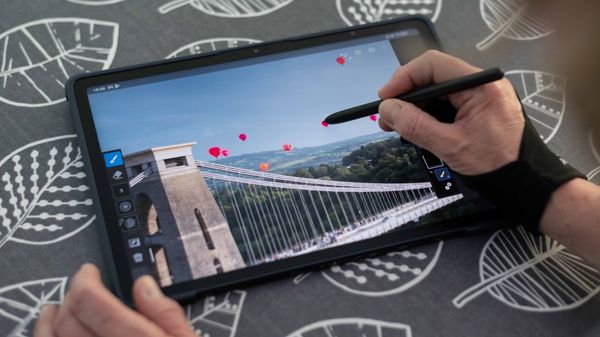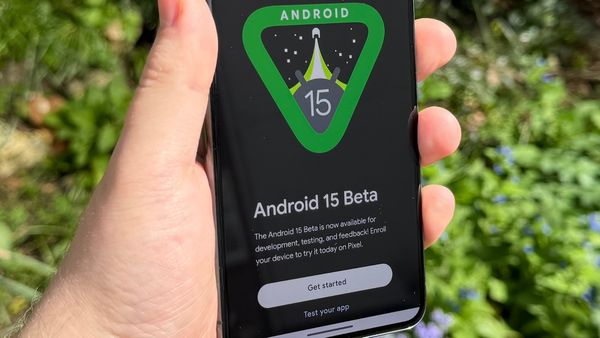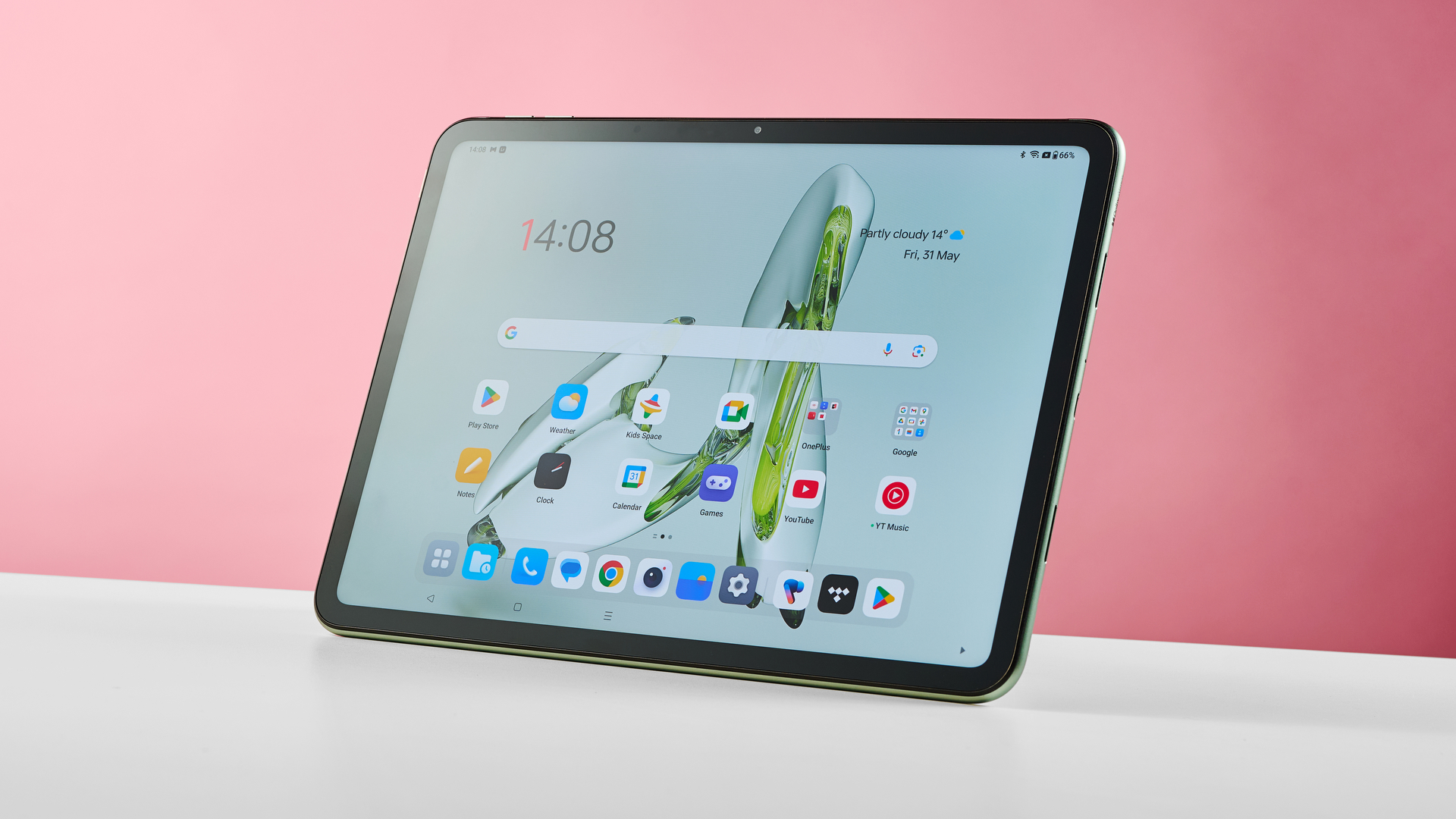
OnePlus Pad Go: one-minute review
The smaller sibling of the OnePlus Pad, the OnePlus Pad Go continues the brand’s tradition of making budget mobile devices to take on the higher-priced giants in the space.
Despite the relatively low asking price, the OnePlus Pad Go still looks like a premium product. It’s light and slender, although a few design flaws undermine the experience in the hand: chief among these is the placement of the camera at the center of the long edge, which is simply asking to be smothered by your fingers every time you grasp it. The build quality doesn’t seem to be up to quite the same standard of more premium tablets either, as I did notice small imperfections in the construction of my test model.
The 11.35-inch, 2.4K display is crisp and conveys colors with brilliant vibrancy, and the 60-90Hz adaptive refresh rate offers a smooth, seamless experience. Despite this, it is overshadowed – literally – by its high reflectivity. Dark hues essentially turn the Pad Go into a glorified mirror, so you’ll struggle to see much of anything in dimly lit scenes.
When it comes to actually using the Pad Go, OnePlus’ Android-based system, OxygenOS, performs well. It ran smoothly during most of my time with it, but I did have a few issues, including the incongruous way you manage app windows, and the inconsistent functionality of the face unlock and auto-rotate features. Those points aside, it was refreshing to be presented with a minimalist Android interface that was as easy to use as that on many of the best tablets.
Performance wise, the Pad Go can handle all the basic tasks expected of a modern tablet, including browsing online content and streaming HD video. It can manage the latter with aplomb, barring the occasional slowdown on loading and buffering, but such occurrences weren’t enough to detract from the overall experience.
It’s also capable of playing the latest and most popular mobile games, albeit they won’t look as impressive as they will on dedicated mobile gaming devices. Productivity is well within the Pad Go’s wheelhouse too, although power users shouldn’t think about substituting it for their laptop or desktop, as it will struggle with high-demand workloads.
The battery life is generous enough to handle a good day’s worth of varied use, and although it does have fast charging capability, it wasn’t that fast, taking around a couple of hours to get back to full. Gaming and other demanding tasks will drain the battery quicker, and the 14-hour video playback claim made by OnePlus didn’t bear out in my tests – it seemed closer to 10.
When stacked up against its nearest competitors, the OnePlus Pad Go’s sleek design and capable performance make it very good value. It won’t be able to handle the most professional of tasks, and it’s a shame the screen is so reflective, but aside from those setbacks, you’ll be hard pressed to find a better tablet that’s cheaper than the OnePlus Pad Go.
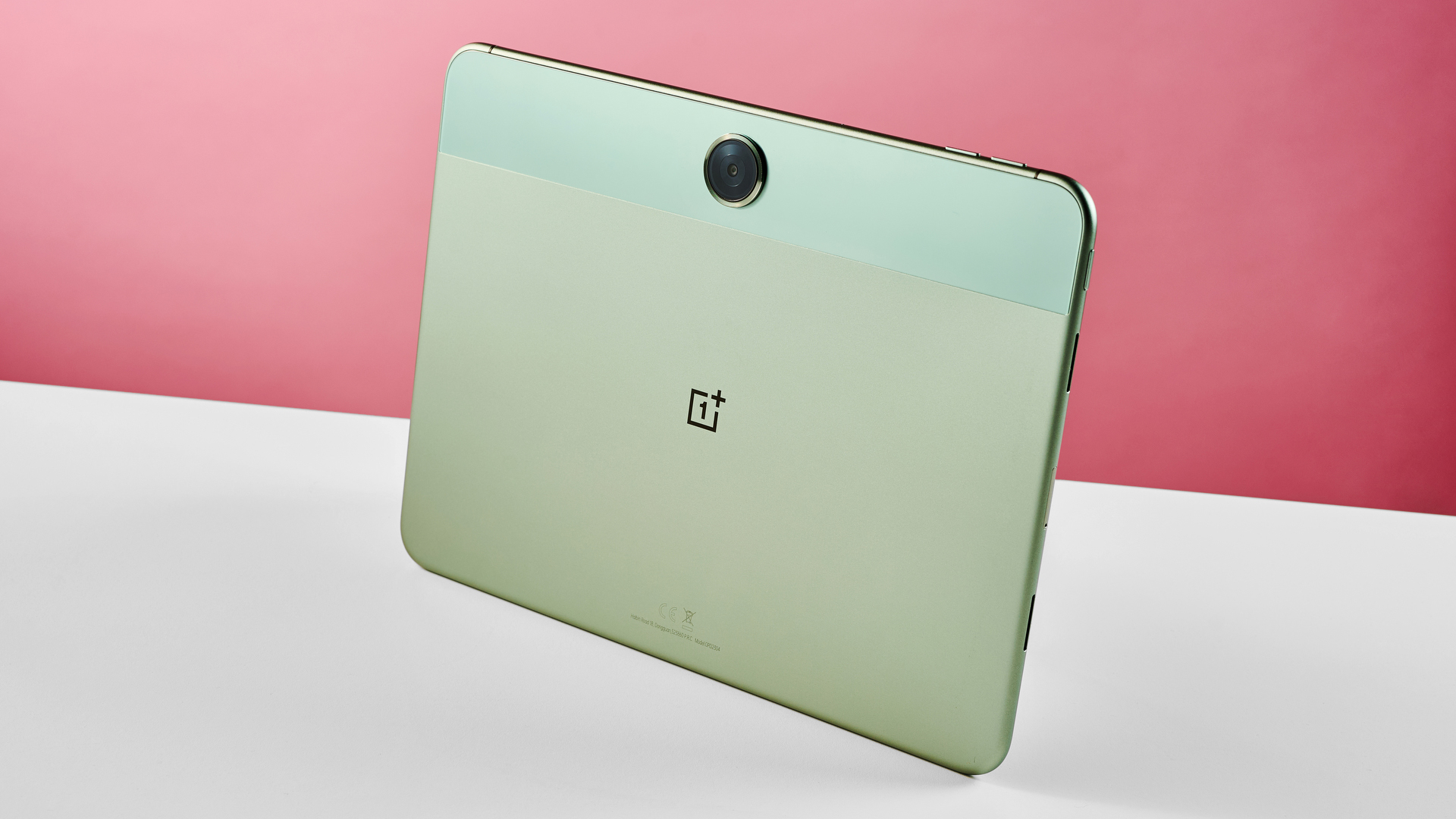
OnePlus Pad Go review: price and availability
- Launch price of £299, but now £269
- Available now in UK only
- Only comes in Green
The OnePlus Pad Go is available now for £269 from the OnePlus website, down from its original price of £299. You can also choose between a charger or the Folio Case as a free gift, but unfortunately there is no official keyboard, at least not yet. Currently, the OnePlus Pad Go isn’t available in the US or Australia.
While £299 is still a large amount of cash to part with, it’s much more affordable than its rivals, particularly the iPad 10.9-inch from 2022, which still retails for £349. For everyday use, the Pad Go offers close to the same performance, working well as a media playback device with light productivity pedigree.
It’s also considerably cheaper than the OnePlus Pad, the company’s higher-spec tablet, which is equipped with a more powerful chip, a better display and a marginally better rear camera.
However, as we noted in our OnePlus Pad review, that tablet still isn’t powerful enough to be a productivity powerhouse, and with that being the case, there’s less reason to buy it over the cheaper Pad Go.
- Value score: 5 / 5
OnePlus Pad Go review: specs
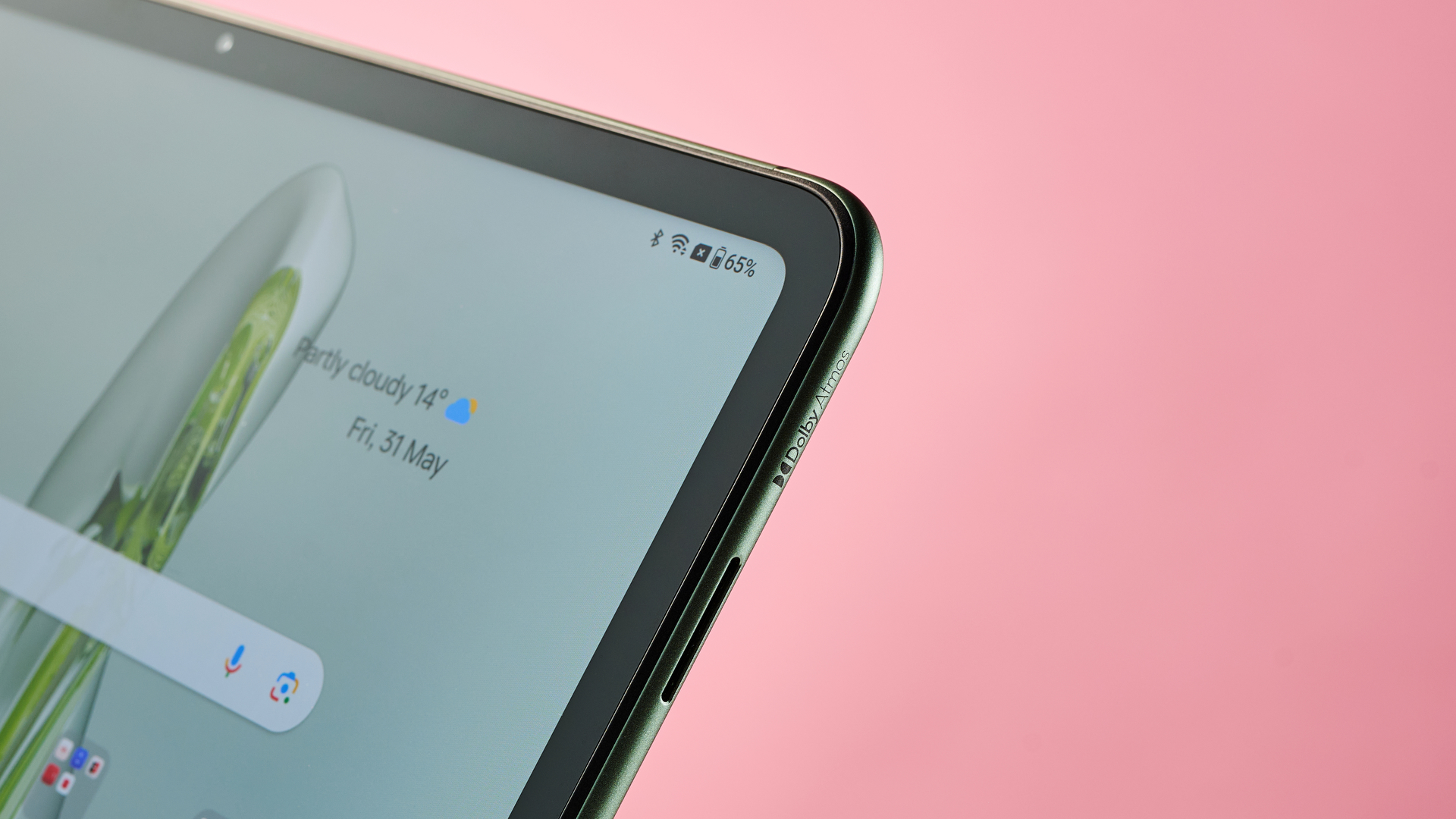
OnePlus Pad Go review: display
- Vibrant and bright
- Effective automatic warmth adjustment
- Reflective screen not great for dark images and video
The 11.35-inch 2.4K display on the Pad Go is, for the most part, a joy to look at. It’s bright and renders colors vibrantly and clearly, and the adaptive refresh rate offers between 60-90HZ, making for smooth transitions. Up against an iPad with an IPS LCD screen, the OnePlus Pad Go acquits itself well.
There are also settings to make the screen easier to look at, such as a reduced blue light mode, which OnePlus calls Eye Comfort, as well as a feature called Nature Tone, which automatically adjusts the display to emit a warmer color palette based on the ambient lighting in your environment. Both of these work well while maintaining the same levels of image clarity.
However, the screen is extremely reflective, which is particularly noticeable with dark images. No matter where you are or what adjustments you make to the brightness settings, this is always a persistent issue, and one of the Pad Go’s biggest weaknesses from a usability perspective. It becomes a real problem when watching movies with darkly lit scenes, and even using dark mode creates noticeably reflectivity.
Smudges, dust and other debris are picked up very easily by the display too. There’s also no fingerprint sensor, meaning you’ll have to secure your Pad Go with a facial scan or a PIN, password or pattern.
- Display score: 3.5 / 5
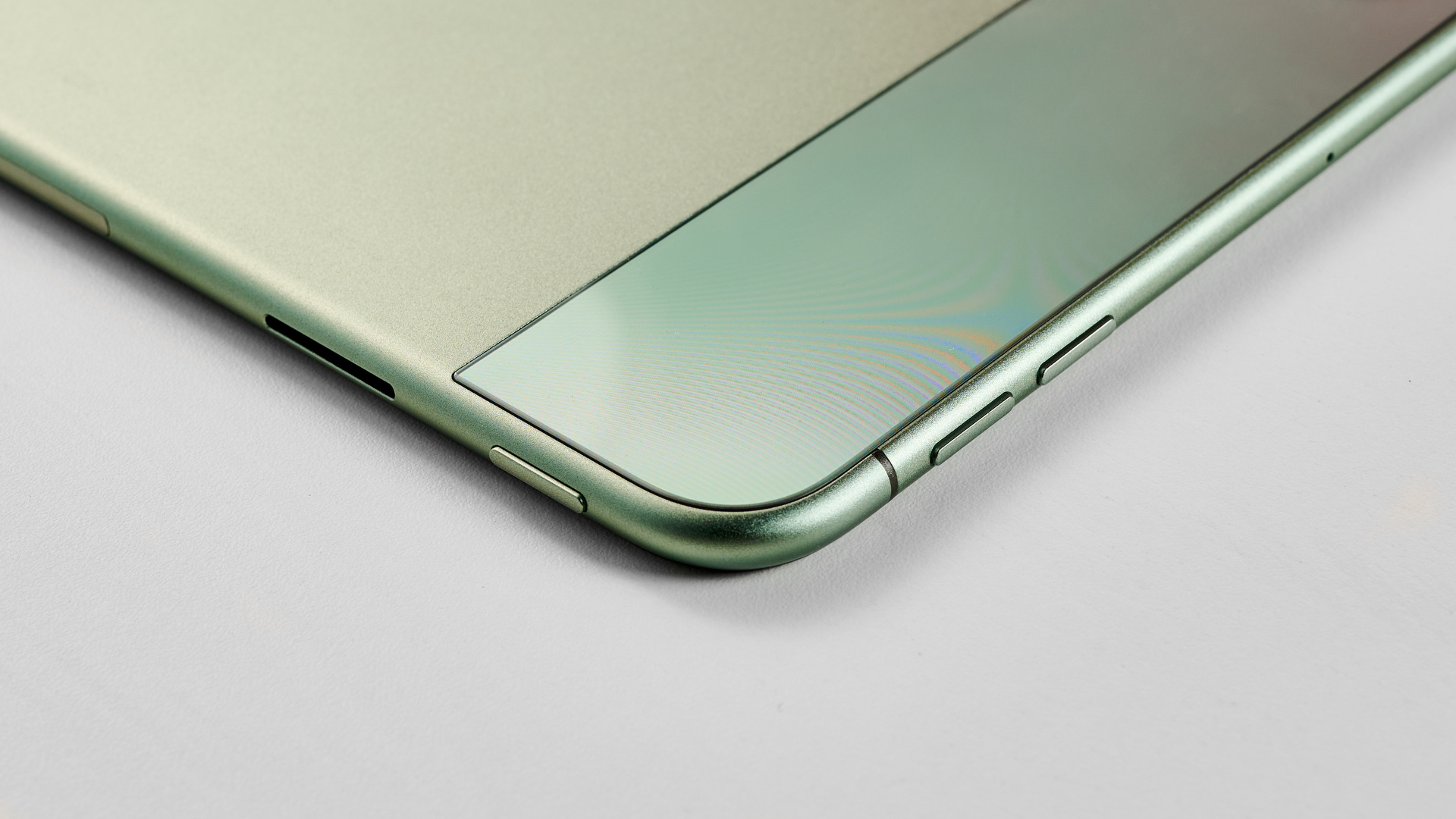
OnePlus Pad Go review: design
- Sleek and slim
- Slightly uncomfortable to hold
- Camera position can be awkward
Opting for a more rounded geometry than Apple’s squared-off look, the OnePlus Pad Go is very sleek and thin, and the materials feel premium to the touch. The bezel that runs along the camera, though, has a finish that picks up fingerprints and smudges very easily, and the join as it meets the chassis is quite pronounced, which you can feel under your fingertips.
The sides are also very acutely curved, which can feel uncomfortable and less secure in the hand. The test model I was given also had a small but noticeable panel gap in the chassis joint on one side, suggesting it isn’t as well-built as its rivals.
Perhaps the biggest contention I have with the design is the position of the camera, which is located in the center of one of the long sides. This makes it all too easy to clasp the lens with your fingers when holding the tablet in portrait. And since the front camera is in the same position, taking selfies in portrait means you’ll have to look askance into the lens, lest you’ll be caught looking off-center in the photo.
- Design score: 3.5 / 5
OnePlus Pad Go review: software
- OS is intuitive and uncluttered
- Almost no bloatware
- A few usability issues with navigation buttons and managing app windows
OxygenOS, the iteration of Android used by the OnePlus Pad Go, is for the most part a robust and very intuitive system to use. It’s very minimal and responsive, rarely getting in the way of the experience. There are also plenty of settings that are easy to find and understand, with useful explanations accompanying many of them.
In practice, the operating system runs smoothly, barring a few minor usability issues. Both the autorotate and face unlock functions were temperamental in my experience, with the former being too eager or not eager enough to switch orientations, and the latter failing half the time to take me straight to the home screen after unlocking, despite the fact I’d toggled the setting instructing it to do so.
Managing multiple app windows isn’t as smooth as it could be either. It takes just a few too many swipes to switch between them, and the Floating Windows feature is too clunky and limited to be used frequently. I also found it to be largely irrelevant, since there aren’t enough compatible apps (the same is also true of the Split Screen function).
As with other Android systems, there is an option to change the navigation method from gestures to buttons, which I personally prefer. However, with the OnePlus Pad Go, the buttons constantly shift position depending on whether or not you’re focused on an app, making it harder to use them than it has to be. The only way to prevent this shifting is if you also disable the task bar along the bottom from showing when in apps.
The aforementioned are only small niggles, though – there is plenty to like about the Pad Go’s software. Mercifully, there is next to no bloatware preinstalled, which can be a common problem with Android devices.
OnePlus has kept everything minimal, and the first-party apps that are present work well and are non-intrusive. The Notes app, for instance, is modeled heavily on Apple’s, and functions as expected, while OnePlus’ own photo gallery app has some useful people-related editing options that aren’t present in Google’s Photos app.
OnePlus has also added what it calls a Gaming Panel, a drop-down menu where you can make various tweaks and access certain tools, such as screen recording, while playing. OnePlus’ HyperBoost Gaming Engine is also located here, which lets you adjust performance modes, ranging from Low Power to Pro Gamer. In practice, however, I didn’t find these modes had any substantial impact on either performance or battery life.
- Software score: 4 / 5
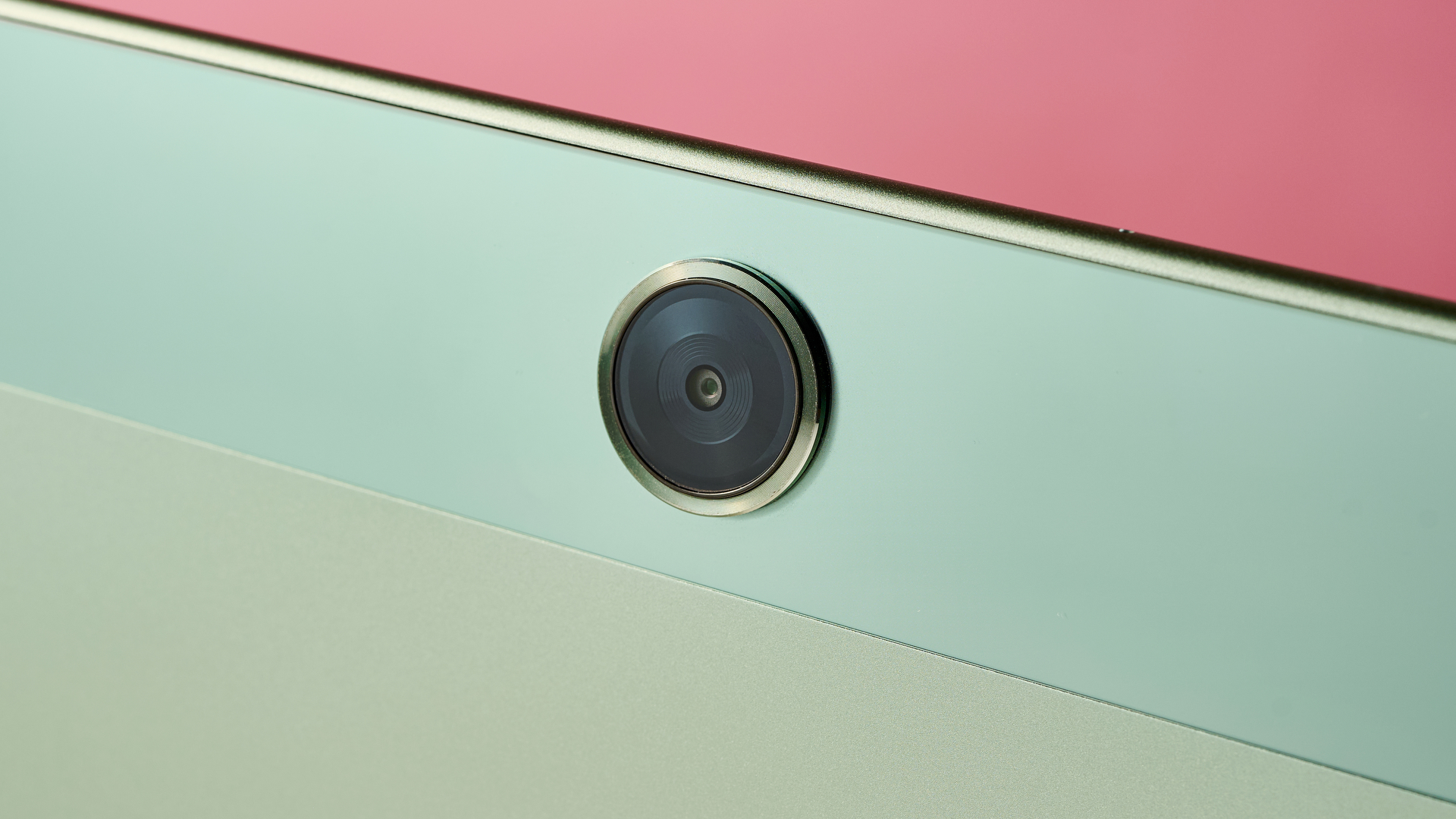
OnePlus Pad Go review: performance
- Helio G99 chip handles work and media playback well
- Mobile gaming graphics somewhat limited
- Speakers are pretty mediocre
The OnePlus Pad Go handles most standard tasks well, from productivity to media playback. The 8GB of RAM is sufficient, and so too is the 128GB of storage. The MediaTek Helio G99 chip is a step down from the OnePlus Pad’s Dimensity 9000, and neither tablet will be able to take the place of a laptop for professional workloads. The Pad Go only suffers from the occasional minor slowdown or stutter, but even with High Performance mode enabled (which is buried in the settings with no shortcut available), I didn’t notice any discernible improvements.
Wi-Fi connectivity doesn’t seem to be the best either. As it happened, during my test I experienced a weak connection. However, my phone was still getting an internet connection, whereas the Pad Go failed to connect until I restarted it.
Mobile games ran relatively smoothly on the whole, although both FIFA Mobile and Call of Duty Mobile did look rather rough around the edges, despite upping the graphics settings as high as I could (in FIFA Mobile, I could not choose high or ultra settings, as the game stated my device did not support them).
Despite warnings about the device getting hot when using Pro Gamer mode, I only ever noticed a slight warming in the top corner of the tablet. But regardless of which mode I chose, I was only able to get around 40 frames per second in Call of Duty Mobile, and FIFA Mobile was capped at 30fps due to the aforementioned lack of device support. Asphalt 9 ran better in my experience, hovering somewhere around the low to mid 50s, but again, the different performance modes didn’t seem to make a difference.
If you’d prefer to use a gamepad instead of a touchscreen, then you can connect a wireless Xbox One controller via Bluetooth. In my experience this worked flawlessly, even letting me control certain aspects of the main UI, although this functionality is limited. I also used a keyboard and mouse for productivity purposes, the former connected via Bluetooth and the latter via the USB-C port. Again, both of these worked without issue. The same was also true when connecting wireless headphones.
When it comes to sound, the four speakers are nothing to write home about. There is a distinct lack of bass, and mild distortion occurs all too easily, as sudden peaks in volume aren’t contained well. The addition of Dolby Atmos, however, is a nice touch. It’s largely redundant when used with the average inbuilt speakers, but when watching movies with a good pair of headphones, it improves the stereo field substantially and imparts a greater sense of space.
The front and rear cameras are middling in their spec, offering only 8MP each and video capture at 30 frames per second at 1080p. There are at least panoramic and time lapse modes, as well as an image stabilization feature. They function well enough, but the 10th-gen iPad is better for shooting, thanks to its 12MP cameras. At this price point, though, there aren’t many tablets that have better cameras than the Pad Go.
- Performance score: 4 / 5
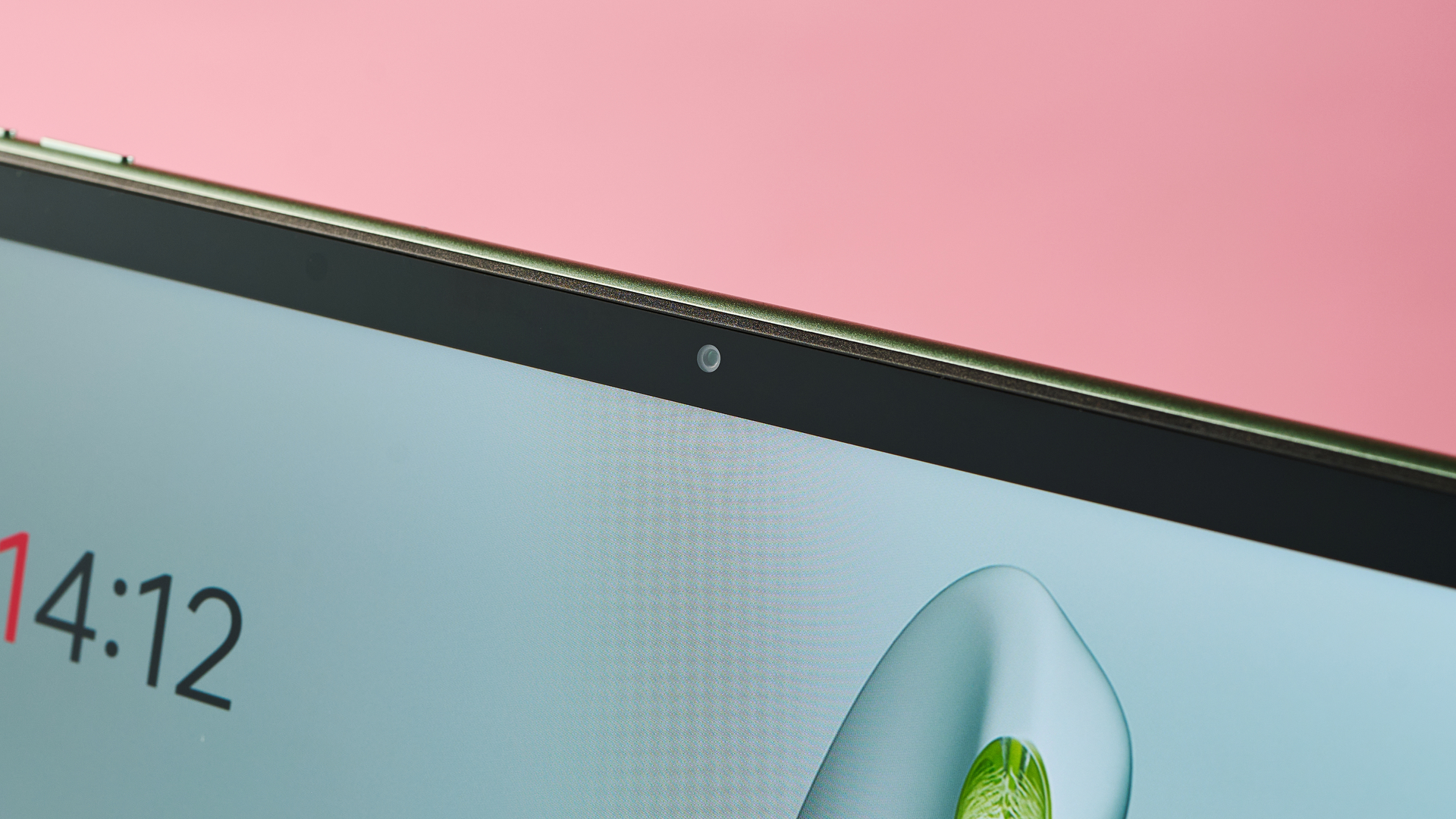
OnePlus Pad Go review: battery
- Lasts over a day for casual use
- But intensive tasks drain it much faster
- ‘Fast’ charging takes two hours to charge to full from 5%
For casual use, I found that the battery life of the Pad Go will last over a day, However, intensive tasks such as gaming will naturally drain the battery quicker. After an hour of gaming, with high performance mode and pro gamer mode turned on, the battery went from full to 85%.
OnePlus claims that the Pad Go will last 14 hours when used for playback alone. During my tests, however, I found this figure to be rather optimistic, as I could only manage around 10.
Fast charging speeds are only adequate: it took two hours to charge to full from 5%, since the Pad Go is only capable of charging speeds of 33W; that’s significantly down on the OnePlus Pad’s 67W capability, which can charge from empty to full in two-thirds of that time.
- Battery score: 3.5 / 5
Should you buy the OnePlus Pad Go?
Buy it if…
Don’t buy it if…
OnePlus Pad Go: Also consider
How I tested the OnePlus Pad Go
- Used the device for two weeks
- Consumed various forms of content, including video, games and music
- Conducted heavy-duty workloads, such as image editing and music production
I spent two weeks with the OnePlus Pad Go. During that time, I used it to watch YouTube videos, live streams and movies, as well as play various games and listen to music.
I also used it for general internet browsing and light productivity, including document writing and spreadsheet creation. For more heavy-duty workloads, I edited images using Adobe Lightroom and played around with the music production app Cubase LE 3.
I used the cameras for taking photos and videos, trying out all the different shooting modes and the integrated editing features. I connected various peripheral devices, such as a keyboard, mouse, and headphones via Bluetooth and the USB-C port.
Read more about how we test.
First reviewed June 2024






